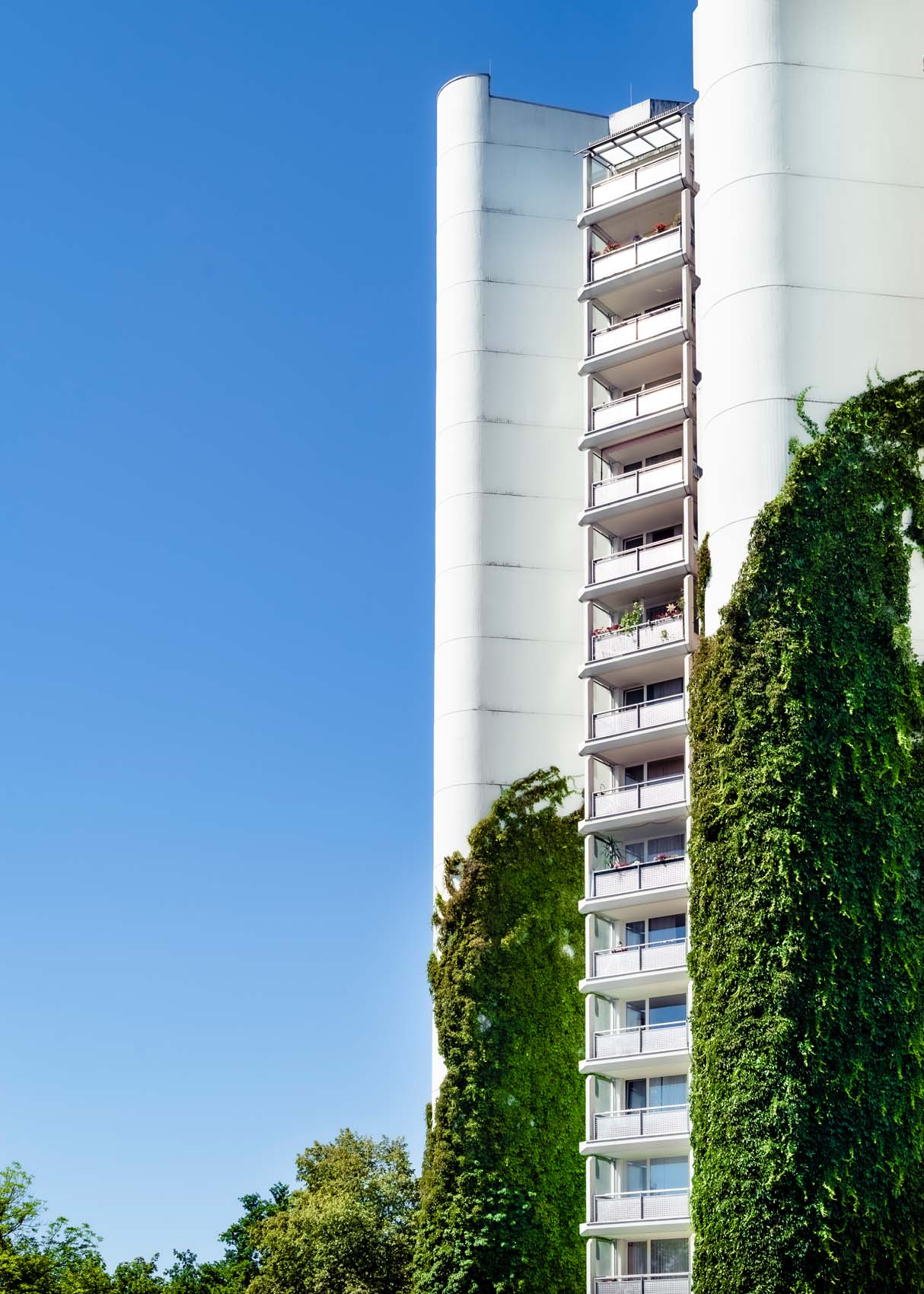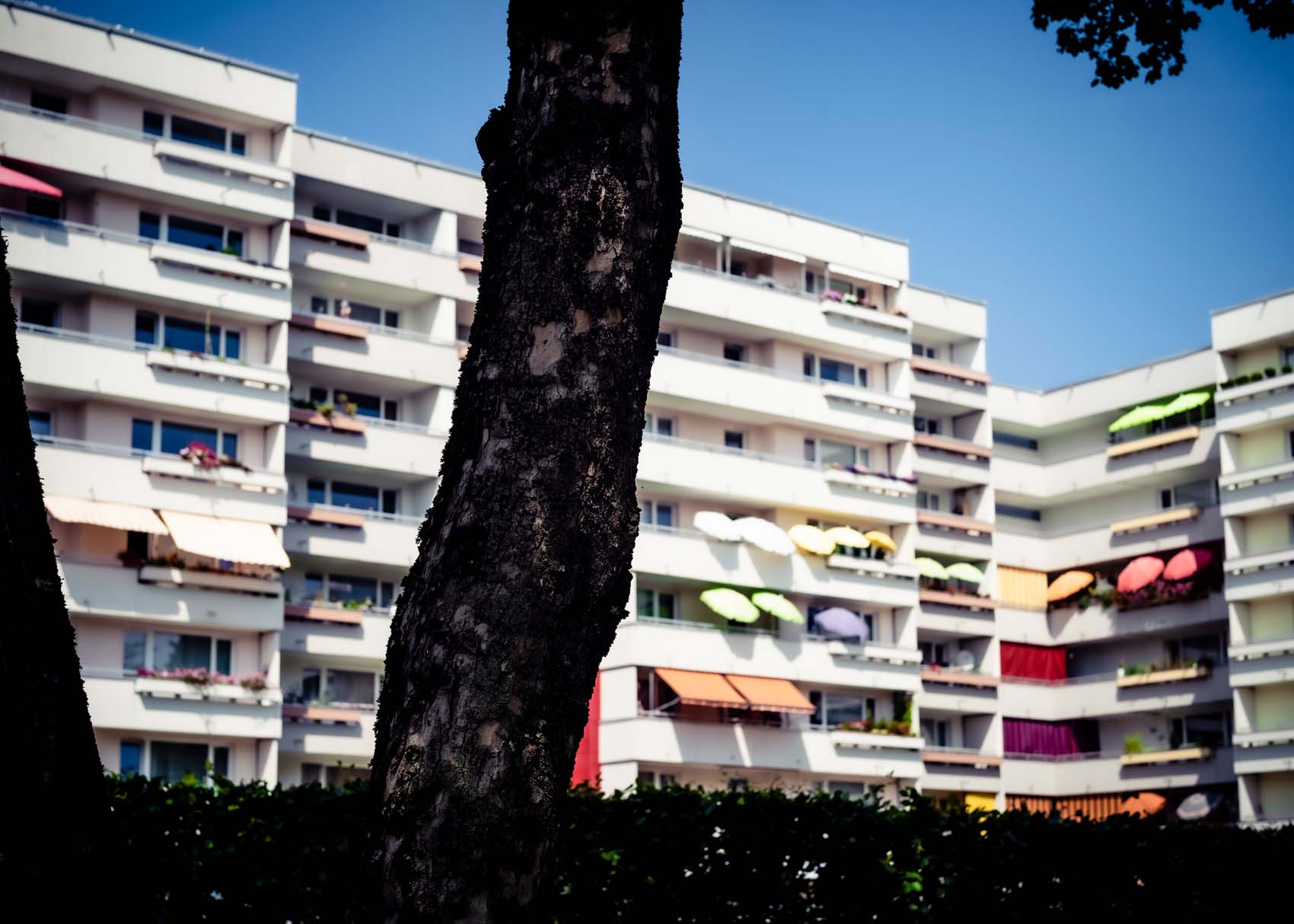A place where new things are emerging and old things are becoming more beautiful.
A place where there is densification, urbanisation and more greenery.
Neuperlach, Munich’s up-and-coming district, is well worth rediscovering. It has always held enormous potential, and its vast reserves of undeveloped land offer an opportunity for sustainable and careful densification of the neighbourhood. It is set to become a pioneering district with improved infrastructure, short distances, excellent transport links and plenty of green – a liveable, modern city next to the city. At the heart of it all sits the iconic „aer“ building that serves as a blueprint for visionary working and living environments.
The „aer“ in Neuperlach is only about 7 kilometres from Marienplatz in the centre of Munich. The central station, Stachus and the airport can be reached in about 20 minutes by U-Bahn or car. Thanks to its location at the southern edge of the city, Lake Starnberg and the foothills of the Alps are not far away either. Neuperlach not only offers excellent connections, a well-established infrastructure and a lot of nature, but also enormous spatial potential for innovative concepts – the best conditions for work and life.
In the 1950s, just as today, the Bavarian capital faced the challenge of creating room for living and working with a limited amount of space. And the city continues to grow, set to surpass the 1.7 million mark in 2030. Munich is popular. In the 2019 city ranking by IW Consulting, Wirtschaftswoche and Immobilienscout 24, Germany’s third-largest city came first. In addition, the metropolis is a dynamic location for business and innovation. It is also a front-runner in the assessment of digital tech hubs in Germany and their future potential (Deloitte 11/2018). Thanks to the diversity of industries and its dynamic character, Munich is one of the leading European economic areas with an economic growth of 72.3% since 2000 – higher than the German average of 53.8%. The „Bavarian metropolis“ is establishing itself as one of Germany’s start-up hotspots.
In short, the university city is developing dynamically, but the supply of space is not. Accordingly, the office market reflects the increasing demand and the dwindling supply. Rare innovative locations such as Neuperlach, with an attractive rent level and close to the city centre, are thus attracting the attention of investors and innovators, established companies and young start-ups.
The „aer“ in Neuperlach is only about 7 kilometres from Marienplatz in the centre of Munich. The central station, Stachus and the airport can be reached in about 20 minutes by U-Bahn or car. Thanks to its location at the southern edge of the city, Lake Starnberg and the foothills of the Alps are not far away either. Neuperlach does not only offer excellent connections, a well-established infrastructure and a lot of nature, but also enormous spatial potential for innovative concepts – the best conditions for work and life.
In the 1950s, just as today, the Bavarian capital faced the challenge of creating room for living and working with a limited amount of space. And the city continues to grow, set to surpass the 1.7 million mark in 2030. Munich is popular. In the 2019 city ranking by IW Consulting, Wirtschaftswoche and Immobilienscout 24, Germany’s third-largest city came first. In addition, the metropolis is a dynamic location for business and innovation. It is also a front-runner in the assessment of digital tech hubs in Germany and their future potential (Deloitte 11/2018). Thanks to the diversity of industries and its dynamic character, Munich is one of the leading European economic areas with an economic growth of 72.3% since 2000 – higher than the German average of 53.8%. The „Bavarian metropolis“ is establishing itself as one of Germany’s start-up hotspots.
In short, the university city is developing dynamically, but the supply of space is not. Accordingly, the office market reflects the increasing demand and the dwindling supply. Rare innovative locations such as Neuperlach, with an attractive rent level and proximity to the city centre, are thus attracting the attention of investors and innovators, established companies and young start-ups.
Micro location
Enormous potential, then as now
People know what Munich means to them; they cherish the city, its beauty and its location at the edge of the Alps on the way to Southern and Eastern Europe. And they know what Neuperlach has to offer. The green meadow in the southeast of the city upon which the district was built from 1967 onwards provided the space for growth that Munich so desperately needed. It alleviated the housing shortage and offered space for offices and commerce.
Over the years, Neuperlach has more than established itself and has long enjoyed the good reputation it deserves. It offers something that other suburbs lack: plenty of green both inside and outside of the neighbourhood. The local recreation areas Michaelibad, Ostpark and the Alpine foothills are easily reachable via the nearby motorway. Neuperlach also boasts excellent local public transport and car connections. Another plus is the established infrastructure, which includes the two shopping centres “Pep” and “Life”.
Micro location
Enormous potential, then as now
People know what Munich means to them; they cherish the city, its beauty and its location at the edge of the Alps on the way to Southern and Eastern Europe. And they know what Neuperlach has to offer. The green meadow in the southeast of the city upon which the district was built from 1967 onwards provided the space for growth that Munich so desperately needed. It alleviated the housing shortage and offered space for offices and commerce.
Over the years, Neuperlach has more than established itself and has long enjoyed the good reputation it deserves. It offers something that other suburbs lack: plenty of green both inside and outside of the neighbourhood. The local recreation areas Michaelibad, Ostpark and the Alpine foothills are easily reachable via the nearby motorway. Neuperlach also boasts excellent local public transport and car connections. Another plus is the established infrastructure, which includes the two shopping centres “Pep” and “Life”.

Something we can appreciate today: the urban planners and sociologists who designed Neuperlach were intent on maintaining large open spaces between the residential and office areas – with green zones that structure the city and a pedestrian system that runs through nature. There is plenty of space to breathe, exercise and play. Neuperlach is a culturally diverse district with a relatively young age structure and comparatively low rent levels. It hence resembles a loosely developed „garden city“ with a friendly, rural feel rather than a soulless commuter town on the outskirts of the city.
The flexible and spacious planning of the founding years now offers the opportunity to close gaps in a meaningful way or to redesign spaces for a more up-to-date purpose.
The current situation is similar to the time when Neuperlach began to develop – with the subtle difference that no further „relief city“ of this size can and is to be built. The city of Munich has great interest in helping Neuperlach, as well as Moosach and the centre of Aubingen, to further raise their profile and enhance their status through investments. This is an opportunity for Neuperlach to become a blueprint for a pioneering district through careful redensification, the creation of more urban green areas and an even more diverse infrastructure. Close to Munich’s beautiful city districts and far away enough to develop its own distinctive identity.
It’s all about preserving what is already there and at the same time permeating old structures with fresh, green ideas that allow any vision to flourish. Today, some 55,000 people live in the 1,989-hectare district with a catchment area of about 400,000 people. These are ideal conditions for a lively, independent neighbourhood that is now continuing to grow organically, making it even more attractive to people, employees and businesses.




